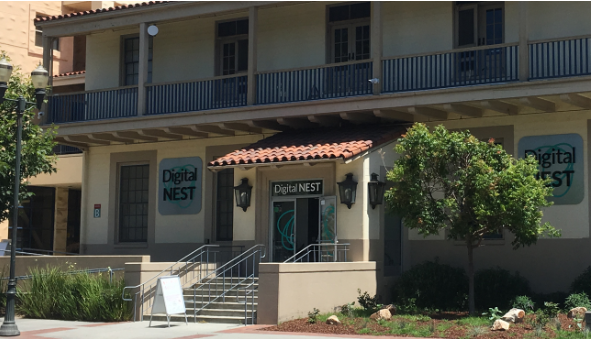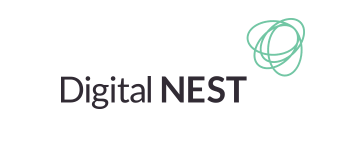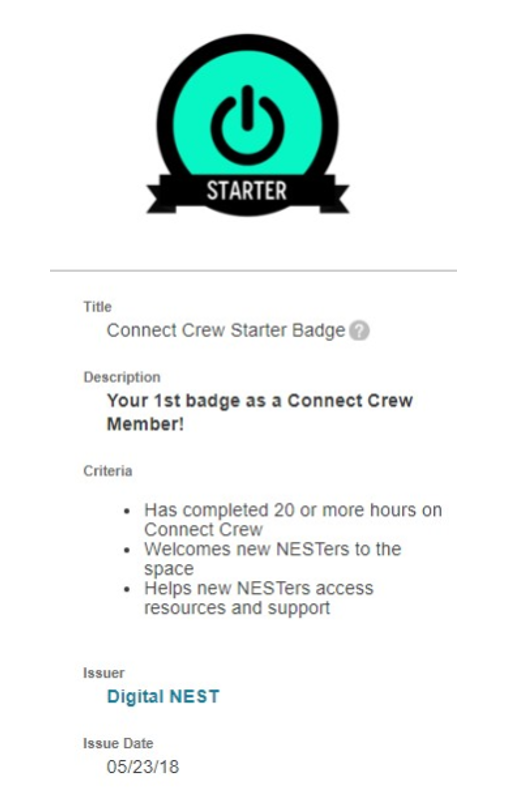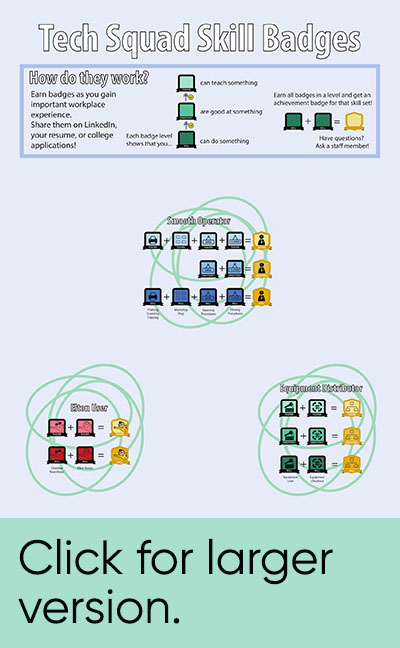8 Tips for Creating a Digital Badging System: Recognize, Encourage and Affirm Youth Who Build Tech Skills
By Shannon Campe | March 4, 2019
Program Manager, ETR
What do you know about badges? I’m not talking about the patch you sew on your Girl Scout vest when you’ve completed your Space Science Explorer requirements. I’m talking about digital badges that people can share widely online.
In a recent study, we set out to see how digital badges could be motivating to learners and useful to educators by creating a badging system for a youth-focused technology program. We’d like to share our learning and encourage you to consider taking similar steps if you’re working in an informal learning space.
What’s the Big Deal About Badges?
Digital badges help educators track their students’ progress. They also equip learners with a tool to acknowledge their accomplishments and show what they are learning—especially in out-of-school settings where there are no diplomas or transcripts. Digital badges are also a way to gamify learning by motivating students to level-up as they achieve new skills or accomplishments.
What Are Digital Badges?
Badges are digital micro-credentials that validate accomplishment, skill, quality or interest. They are “packaged” in a digital file, represented by an icon. The file holds the description of the badge, who issued it and the criteria required to receive it.
Early work in digital badges by Mozilla and the MacArthur Foundation led to the development of the “Open Badges” technical standard—a group of open source specifications and standards that enable badges to be shared within learning management systems and, more widely, through social media. There is now even an annual summit all about digital badges.
The free online learning resource Kahn Academy has an extensive badging system. These badges can be earned by tasks ranging from watching videos to completing programming challenges. Other informal learning organizations use badges to create and track learning pathways.
Badging is also used in formal learning settings such as K-12 school districts, community colleges and universities to track learning and mastery of workforce skills.
Value Potential
There is great potential for badges to be valuable for industry when it comes to hiring competent employees. Some companies host their own online skills academies with badges directly related to skills they care about. But for badges to be valuable in the workforce—and therefore valuable to learners—stakeholders need to work together to articulate what skills are relevant.
Researchers have been studying how to implement badging in different settings. They have examined the value and motivation badges hold for computer science education and how students think about their identity and competence in relation to STEM learning. Others are looking at badges for assessment of online learning.
Our Research Partnership with Digital Nest

We tried out different approaches, we made some mistakes, we achieved some successes. We’ve distilled much of our learning into 8 tips that can help programs develop and sustain effective badging systems. We hope by telling our story, others can learn from us and be encouraged to dive into implementing an open digital badging system.
About Digital NEST

8 Tips: Getting the Most Out of Your Digital Badging System
1. Identify your goals.
Ask yourself, why set up a digital badging system? Is it about recognizing learners’ accomplishments? To motivate learners to do more – including taking on leadership roles? To track what they are accomplishing? To help them share acquired skills outside of your organization (e.g., LinkedIn, job and school applications)? Getting clear on priorities helps in planning next steps for implementation.
Our project set out with all these goals in addition to contributing to the research on motivation and value of digital badging in informal learning settings.
Based on others’ advice, we started small. First, we created and awarded “participation” badges to a select group of members. Additional goals for these badges were to acknowledge members for their volunteer efforts, help staff track member engagement and to test the features of creating, awarding, tracking and promoting badges.
Next, we created skill badges for a group of members who support the technology needs of the NEST—those who provide and update hardware, manage software and manage inventory databases. Additional goals for these badges were to validate members’ acquired skills and increase their motivation to acquire skills with a focus on being able to lead others in their skill acquisition.
2. Select your badging system.
Consider the technological resources you have. If you have less money and fewer resources, you’ll probably need to work within a more packaged system, which will have greater design limitations. Consider how your organization will award and track badges. See this resource for a list of platforms to consider.
We chose the online platform Credly.com because badges could be designed and awarded by ETR-NEST and viewed and shared by members who received them—all without any programming on our end. We were also able to upload custom images to better correspond with member groups’ identity.
Member Feedback on Badges: Feeling Good About Accomplishments
“Yeah, what you’ve accomplished. It makes you feel really good, knowing that you do something for the NEST.”
3. Work backwards from what you want badge earners to be able to show others.
Once you know where you’re going, you can work out what needs to happen to get earners there (criteria, levels). Think about how often they will have the opportunity to earn a badge. Some examples of design tools can be found here, here and here, and you can hear about digital badges for youth here and here.
For participation badges we started with one group of members and expanded to five different groups, each with distinct volunteer responsibilities. We developed measurable attendance and responsibility objectives of 3 different levels (Starter, Active, Leader) that were tracked by NEST staff monthly and shared with ETR.
For skill badges, ETR worked closely with Yazmin Herrera, Assistant Program Director at the Digital NEST. The focus was on offering leveled badges that could capture where members are in their skill acquisition and provide members with the opportunity to strive to learn more so they can teach and lead others in information technology.
For example, the “Equipment Checkout” set of badges shows that a member knows how to use the NEST’s Salesforce account to check out laptops or other hardware to other members. Level 1 of this badge is earned when a member successfully demonstrates this skill to an assessment proctor. Members then move up to Level 2 when they show that they can consistently demonstrate the skill over time. Finally, the Level 3 “Teacher” badge is awarded to those who teach newer members how to check out equipment as evidenced by newer members earning their own Level 1 badge.
Across the course of two years, 15 Participation and 12 Tech Skill badges were developed and awarded to members. All in all, 26 members were awarded one or more badges.
The first “Starter” participation badge a member in the Connect Crew group receives.
4. Work with all stakeholders to identify criteria and value of badges.
Work with people in industry and education and talk with employers. You’ll also want to include the earners themselves. They will help you develop criteria that make the badges applicable to their learning needs, offer value for potential earners, and provide motivation to earn and share them. See examples of a high school working with the biotechnology industry and a webinar on aligning employers and institutions.
NEST-ETR staff worked closely to identify badge criteria based on the foci and responsibilities already established within member groups. Within the duration of the project there was limited time to expand into additional member-interest badges and/or work closely with local industry to align with their needs.
Member Feedback on Badges: Motivation
“Well I think there’s something good to like put on maybe like resumes or fact sheets, recommendation letters in my case. Because they will see the kind of work you do at the NEST, so they’ll see the kind of motivations and commitment you’re a part of.”
5. Plan for high visibility and marketing.
This increases motivation and value. Create posters or other visuals that show what badges can be earned, including progression of levels. Make it obvious what is needed to earn the badge and how earners will be assessed on the criteria
NEST staff promoted the badges in house by including announcements in their e-newsletter. They also posted visual icons showing badges awarded to members next to their names on volunteer schedule boards. A poster was created to share the structure of tech skill badges with members.
6. Use a digital platform such as a learning management system (LMS).
Make sure it’s one where earners can engage easily, both to check on and share their own badges and to see those earned by others across the organization. This can also help you to track and report on earned badges.
Originally there were plans for all NEST members to regularly utilize an LMS that would have badge sharing built in. Instead, an alternative system for tracking and awarding was implemented. This was successful, but the lack of a shared online platform limited badge exposure since members had to check email and log on to Credly.com to view and share their badges.
7. Have badge information meetings.
These can show earners how to access and share badges across social media. Earners can also share badges through hyperlinks that document criteria and who awarded it—useful when submitting resumes electronically. Even if sharing capabilities are limited, show earners how they can extract criteria from the badges to indicate their skills on job or school applications.
How-to documents showed members how to set up their Credly account and manage badges. NEST staff talked to members individually and in groups about what badges were available and how to earn them. In retrospect, we believe more targeted badge information meetings for all member badges might have encouraged more buy-in to earn them.
8. Plan for sustainable training and assessment.
Identify clear assessment guidelines based on badge criteria, especially for skill badges. Assign and train an assessment proctor to review artifacts (the materials or objects created by earners) or have badge earners demonstrate skills.
Tech skill badges included a system of training members on the skill and then tracking when they were ready to be assessed by trained NEST or ETR staff. Due to the fluidity of members’ engagement in an out-of-school setting this was challenging but various iterations of a clear assessment system led to the successful awarding of multiple badges.
An effective badging program takes time and commitment by all those involved, especially at the start. Keeping these 8 Tips in mind can help you and your team hit the ground running. You can also check out a short piece on the Seven Deadly Sins of Badging in Education to remind you of what not to do.
Shannon Campe is a Program Manager at ETR. Her work focuses on bridging research and practice in K-12 STEM education. You can reach her at shannon.campe@etr.org







